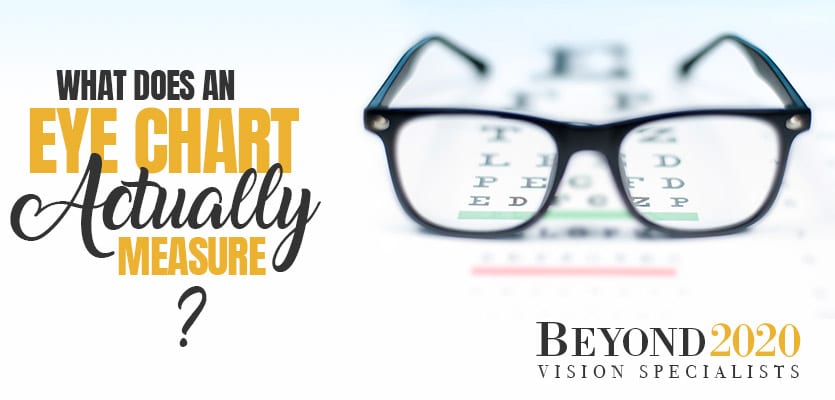What does an eye chart actually measure?
Home » What does an eye chart actually measure?

What an Eye Chart Measures
At some point in your life, you’ve likely seen an eye chart hanging on the wall at an optometrist’s office or a nurse’s office at your school. Even your physician’s office likely has one of these charts hanging up. These charts are and have always been exceedingly popular because of how effective they are at measuring a person’s vision. The following offers an explanation of the importance of eye charts and what they actually measure.
Why You May Have Poor Vision
While it’s possible that your vision could remain perfect your entire life, many people will eventually experience poor vision or a reduction in visual acuity. The main cause for these issues is a simple refractive error. These errors can include abnormalities with the shape of your cornea, your lens having less flexibility because of your age, and irregularities with your eye shape. The eye-related issues that occur due to age will likely start to develop when you’re in your 40’s. If you’ve been diagnosed with diabetes in the past, you have a higher risk of developing eye problems.
How Vision is Properly Measured
A person’s vision is usually measured with a standard Snellen eye chart. These charts are able to measure how well you can see from specific distances. If you have been told that you have 20/20 vision, this measurement comes from the results of looking at an eye chart. Many people mistakenly believe that 20/20 vision is the best vision that they can have. In fact, 20/20 vision is actually normal vision, which means that it’s possible for your vision to be even better.
When a comprehensive eye exam begins, your eye doctor will ask for you to read single letters that are situated in multiple lines. Starting from the top, each row of lines gets smaller and smaller until you reach the bottom of the eye chart. If you’re able to read some or all of the letters that are found on the bottom row, you can be confident that your visual acuity is great.
It’s important to understand that the standard distance for an eye exam is 20 feet. If you’re told that you have 20/20 vision, this means that your eyesight is exactly how normal eyesight would be at a distance of 20 feet. In the event that your vision is 20/40, this indicates that you can see at 20 feet what someone with normal vision can see at a distance of 40 feet. Although less common, it’s possible for someone to have a visual acuity of 20/15 or even 20/10.
To understand exactly how this eye chart works, consider the standard distance of 20 feet. From here, a person with 20/20 vision will be able to read the smallest line on the chart without issue. This line subtends an angle of five minutes of arc. The spaces between each line as well as the thickness of these lines subtend a single minute of arc. When taking this into account, the letters on the lowermost row should be around 8.73 millimeters tall. The E letter on the uppermost row should be 87.3 millimeters tall.
Most Common Types of Eye Charts
Even though the Snellen eye chart is the most common type to be used by eye doctors, there are numerous types of eye charts that can be used to perform a visual test. The Snellen eye chart is known for starting with the letter E, which is the top line and the most visible letter on the chart. The lines following the letter E become progressively smaller. In total, this chart consists of 11 separate rows of letters that can be viewed during the exam. This particular chart was developed in 1862 by Dr. Hermann Snellen and has since been the standardized eye chart.
Another common eye chart that was also designed by Dr. Hermann Snellen is the tumbling E chart, which is used specifically among younger children or other individuals who don’t yet know how to spell the alphabet. Just like the Snellen chart, the tumbling E chart begins with the letter E. However, the similarities end there.
The rest of the chart is comprised solely of the letter E in its capitalized form. However, the E can be rotated in four directions. When a young child is taking an eye exam with the tumbling E chart, they will be asked to point their finger in the direction that the E is pointing to. If the E is backward, the person taking the exam must point their finger to the left.
Two additional charts that can be used to test vision include the Jaeger eye chart and the Landolt C chart. The Jaeger eye chart is a type of handheld chart that’s designed specifically to measure someone’s near vision acuity. If you happen to use the Jaeger eye chart while going through an eye exam, you must position the handheld chart 14 inches away from your face. At this point, you’ll be asked to read the smallest block of text that you can read without squinting.
As for the Landolt C chart, this is another chart that’s commonly used by eye doctors. The first row on this chart includes three capitalized C letters. Each line will feature more C’s that are smaller than the ones on the rows above. Eventually, the C’s will all but disappear. This particular eye chart is comprised of 13 rows.
What Different Levels of Vision Indicate
As touched upon previously, the results of your vision test could be anywhere from 20/10 to 20/200. Normal vision occurs at 20/20. In order for someone to become a fighter pilot, their vision must be at least 20/20. If you have 20/20 vision, you should be able to read telephone numbers in a phone book without needing to squint to do so. At 20/40 vision, you’ll be able to pass a driver’s license test. However, you must wear contact lenses or glasses.
If your vision happens to be 20/80, you’ll still be able to read a digital alarm clock at a distance of 10 feet. Even though a person is deemed to be legally blind with the eyesight of 20/200, it’s still possible to read signs with some special lenses. If your eyesight is close to 20/40 or above, it’s highly recommended that you look into contact lenses or eyeglasses to provide you with sharper vision and better clarity.
Call our Odessa eye doctor today to schedule your consultation and to learn more about how our optometry care can help you.

